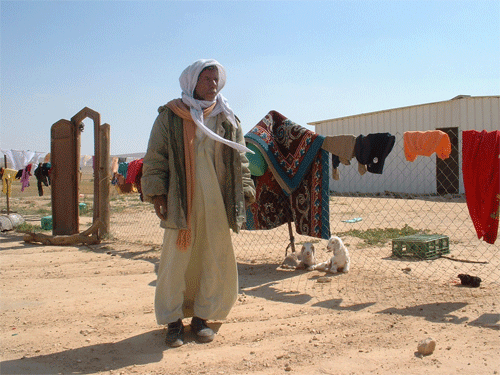
An old Bedouin man in the unrecognised village of Abda, in the southern Negev,
in March 2003.
Photo: Jonathan Cook
|

An old Bedouin man in the unrecognised village of Abda, in the southern Negev, in March 2003. Photo: Jonathan Cook |
| Rahat, March 31 |
|
Later in the day, at the Al-Tayf home, we hear nearby shooting. The daughters say there's a 'tosheh' (clash) among the Haza'el. I ask how can they have guns? They say that several Haza'el men are in the army; they are permitted to bring their guns home with them. After a while we see a car speeding out of Rahat. Already the daughters know that someone has been wounded. It's striking, the speed with which women who almost never leave home know about neighbourhood events; whereas I, who am free to come and go, never know what's happening outside my home. Umm Azmi's daughters spend a lot of time on the roof.
In the evening I ride back to Lakiya with Abu and Umm Azmi who are going to attend a wedding celebration there. I hope to meet Amal S. there -- she has been recommended to me as an educated young woman who works, still rare in the Nagab. After many fruitless phone calls I find her in her family home. She says she will be at the wedding. I discover too late that there are two weddings in Lakiya that night. The one Abu Azmi is invited to is not the Sanaa wedding where Amal will be. An attempt next day to find Amal in her Lakiya home fails. I sit for a while and chat with her father, who asks me questions about the refugees in Lebanon. Nagab people show an awareness of the harsh situation of Palestinians in Lebanon that I haven't |
encountered in Gaza or the West Bank, where there is much ignorance and even bias. Perhaps it is because both groups share isolation and neglect as well as oppression.
Sunday April 2: Hassan takes me to Bir Sabaa to meet Amal S. in her office. It's a good meeting. She suggests a new way to contact Fadhiya Abu Ghurood, a bedouin woman famous for having carried out a sit-in outside the Knesset. Though I usually avoid 'known' people I badly want to record with Fadhiya, both because of what she did, and because meeting her will be so difficult. She lives deep south into the Nagab, among her tribe the Azazmeh, in an area without paved roads, and strictly controlled by a net of Israeli security and local sheikhs. All the Azazmeh's former territory has been expropriated by the state, and they are said to be the poorest people in the Nagab. Amal also puts me in touch with Attiyeh Abu Kassem, head of the Regional Committee for the Defence of Unrecognized Villages. By now I have gathered that displacement is not something that happened in the past but an ongoing process. Three sites of current tension that I can reach easily are the Tarrabin near an Israeli settlement called Omeh; the Dirijat near Arad; and the Abu Salb. In Amal's pffice I meet Ghaliya, who wants me to record with her mother. |
[Umm Tamim] [Women of the Tarrabin] Copyright©2005 |
|